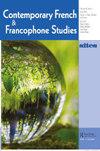The Sound of the Soul Mediated through Voice and Music in an Early Proustian Manuscript (“Après la 8e symphonie de Beethoven” [“After Beethoven’s Eighth Symphony”])
IF 0.2
4区 文学
0 LITERATURE, ROMANCE
引用次数: 0
Abstract
AbstractIn The Mysterious Correspondent: New Stories, two manuscript fragments, under the title “After Beethoven’s Eighth Symphony,” highlight Marcel Proust’s exploration of the possibility of deep spiritual communication between individuals. In each fragment, the qualities of the human voice and symphonic music are compared, underscoring the extent to which the emotional and aesthetic effects of sound depend on milieu and medium. The limitations of conversation as a means of achieving spiritual intimacy contrast dramatically with the potential of music to engender more profound human connections. This juxtaposition of voice and music gives readers a glimpse of Proust’s early efforts to transpose into words the seemingly ineffable qualities of music.Keywords: ProustBeethovenvoicemusicmanuscriptspirituality Notes1 Unless otherwise noted, the English versions of The Mysterious Correspondent: New Stories are from Charlotte Mandell’s translation.2 Suzette Lemaire was the daughter of Madeleine Lemaire, an artist in her own right, known for her paintings of flowers, who entertained members of high society as well as artists and intellectuals at her salon on the rue de Monceau in Paris. Marcel Proust and Reynaldo Hahn met at one of Madeleine Lemaire’s soirées in 1894, around the time Proust was writing the manuscripts compiled in Le Mystérieux Correspondent.3 All unattributed translations are mine.4 In the Recherche, we see a similar juxtaposition when the banalities of conversation clash with the elation inspired by Vinteuil’s music. At the Verdurin salon between movements of the septet, audience members chat briefly with the Proustian protagonist: “Un duc, pour montrer qu’il s’y connaissait, déclara: ‘C’est très difficile à bien jouer.’ Des personnes plus agréables causèrent un moment avec moi. Mais qu’étaient leurs paroles, qui, comme toute parole humaine extérieure, me laissaient si indifférent, à côté de la céleste phrase musicale avec laquelle je venais de m’entretenir?” (Proust 3: 762) [“A duke, in order to show that he knew what he was talking about, declared: ‘It’s a difficult thing to play well.’ Other more agreeable people chatted for a moment with me. But what were their words, which like every human and external word left me so indifferent, compared with the heavenly phrase of music with which I had just been communing?”] (Moncrieff 5: 344).5 For example, the Proustian narrator links the shape and color of Bloch’s nose to the nasal quality of his voice: “Son nez restait fort et rouge, mais semblait plutôt tumifié par une sorte de rhume permanent qui pouvait expliquer l’accent nasal dont il débitait paresseusement ses phrases, car il avait trouvé, de même une coiffure appropriée à son teint, une voix à sa prononciation, où le nasonnement d’autrefois prenait un air de dédain d’articuler qui allait avec les ailes enflammées de son nez” (qtd. in Pisano, p. 112).Additional informationNotes on contributorsHollie HarderHollie Harder is Professor of French and Francophone Studies at Brandeis University in Waltham, Massachusetts. She has published articles on Émile Zola and Michel Houellebecq, in addition to works on Marcel Proust, which include “On the Beach and in the Boudoir: Albertine as a Classical Amazon Figure in Marcel Proust’s À la recherche du temps perdu” in French Forum, “Proust’s Human Comedy” in The Cambridge Companion to Proust, and “Proust’s Novel Confections: Françoise’s Cooking and Marcel’s Book” in Modern Language Studies.早期普鲁斯特手稿中以声音和音乐为中介的灵魂之声(《贝多芬第八交响曲之后》)
在《神秘的通讯员:新故事》中,两篇题为“贝多芬第八交响曲之后”的手稿片段,突出了马塞尔·普鲁斯特对个体之间深层精神交流可能性的探索。在每个片段中,比较了人声和交响乐的品质,强调了声音的情感和美学效果取决于环境和媒介的程度。对话作为一种获得精神亲密的手段的局限性,与音乐产生更深刻的人际关系的潜力形成了鲜明的对比。这种声音和音乐的并列,让读者得以一窥普鲁斯特早年的努力,他将音乐看似难以形容的品质转化为文字。关键词:普鲁斯特贝多芬音乐手稿灵性注释1除特别注明外,《神秘通讯员:新故事》的英译本均来自夏洛特·曼德尔的译本苏泽特·勒梅尔是马德琳·勒梅尔的女儿,马德琳·勒梅尔是一位独立的艺术家,以画花而闻名,她在巴黎蒙索街的沙龙里招待上流社会的成员、艺术家和知识分子。马塞尔·普鲁斯特和雷纳尔多·哈恩于1894年在玛德琳·勒梅尔的一次聚会上相识,当时普鲁斯特正在写《秘密通讯》的手稿。所有未署名的翻译都是我的在《追思》中,我们看到了类似的并置,当谈话的陈腐与文特伊音乐所激发的喜悦发生冲突时。在Verdurin沙龙上,在七重奏的乐章之间,观众们与这位普鲁斯特式的主角简短地聊天:“unduc, pour montrer qu ' il s ' y connaisit, dsamclara: ' C ' est tr difficile bien jouer。”他说:“这些人加上可变性的人造成的后果是,每时每刻都在改变。”但是瞿'etaient帮助他们解脱,,,像吹捧假释humaine exterieure,我laissaient si漠不关心,象牙海岸de la celeste短语音乐会用的那个我venais m 'entretenir ?(普鲁斯特3:7 62)“一位公爵,为了表明他知道自己在说什么,宣称:‘演奏好是一件困难的事情。还有一些比较随和的人和我聊了一会儿。但是,他们的话,就像所有的人和外界的话语一样,使我如此漠不关心,与我刚才交谈的神圣的音乐相比,又算得了什么呢?(Moncrieff 5: 344)例如,普鲁斯特式的叙述者将布洛赫鼻子的形状和颜色与他声音的鼻音联系起来:“Son nez restait fort et rouge, mais semblit plutôt tumififiee par one sorte de rhume permanent qui pouvait expliquer l 'accent鼻音don ' il danci.com/ com/发音,car il avit trouvise, de même one coffent concient danci.com/, one voixcom/发音,où le nasonement d 'autrefois prepreit air de danci.com/和'articuler ququestall ' aanci.com/”(qtd)。《皮萨诺》,第112页)。作者简介:霍利·哈德是马萨诸塞州沃尔瑟姆市布兰迪斯大学法语和法语研究教授。她曾在Émile Zola和Michel Houellebecq上发表文章,此外还发表了关于马塞尔·普鲁斯特的作品,其中包括《在海滩和闺室:马塞尔·普鲁斯特的À la recherche du temps perdu中的阿尔贝蒂娜》在法国论坛上,《普鲁斯特的人类喜剧》在《剑桥普鲁斯特伴侣》上,以及《普鲁斯特的小说糖果:弗朗索瓦兹的烹饪和马塞尔的书》在现代语言研究。
本文章由计算机程序翻译,如有差异,请以英文原文为准。
求助全文
约1分钟内获得全文
求助全文
来源期刊

Contemporary French and Francophone Studies
LITERATURE, ROMANCE-
CiteScore
0.30
自引率
0.00%
发文量
43
期刊介绍:
An established journal of reference inviting all critical approaches on the latest debates and issues in the field, Contemporary French & Francophone Studies (formerly known as SITES) provides a forum not only for academics, but for novelists, poets, artists, journalists, and filmmakers as well. In addition to its focus on French and Francophone studies, one of the journal"s primary objectives is to reflect the interdisciplinary direction taken by the field and by the humanities and the arts in general. CF&FS is published five times per year, with four issues devoted to particular themes, and a fifth issue, “The Open Issue” welcoming non-thematic contributions.
 求助内容:
求助内容: 应助结果提醒方式:
应助结果提醒方式:


